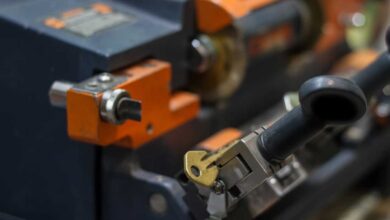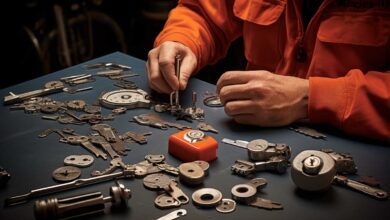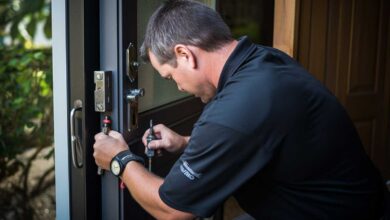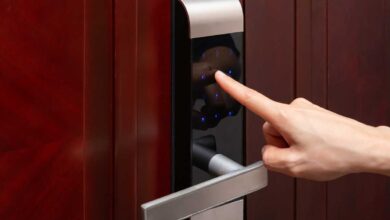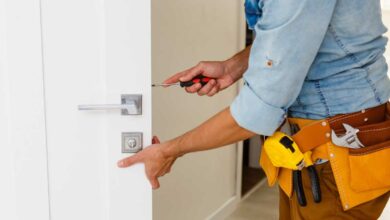Understanding Home Lock Mechanisms
KEY TAKEAWAYS
Lock mechanisms are vital for home security, preventing unauthorized access, and ensuring peace of mind. At their core, they feature a lock cylinder, latch bolt, and a locking method. When the right key is used, the latch bolt retracts, opening the door.
Types of locks range from traditional cylinder and mortise to modern smart locks with remote features. The right choice, whether a high-security or smart lock, boosts your home’s safety, depending on your door type and security needs.
Types of Home Lock Mechanisms
Securing your home requires knowledge of various lock mechanisms to bolster overall safety. The cylinder lock, commonly found in homes, uses pins in a cylinder; when aligned with the right key, it unlocks. For advanced security, electronic locks offer features like keypads, fingerprint scans, and smartphone integration for controlled access and monitoring. Deadbolts, providing superior security, have a metal bolt for added protection. They come in single or double-cylinder designs.
Mortise locks, usually seen in older homes, contain mechanisms within a rectangular pocket and offer durability. Conversely, knob locks, suitable for interior doors, should be paired with robust locks for external doors due to their vulnerability. When picking locks, consider your door type and the security level needed. High-security varieties like rim or stand-alone locks resist forceful entries, which is ideal for external doors. Always match locks with your door’s material and style.
In essence, knowing different lock mechanisms is paramount for home security. Whether it’s traditional, electronic, or deadbolt locks, the right choice ensures safety and peace of mind. Seek expert advice from locksmiths for tailored recommendations.
Traditional Door Locks
Traditional door locks, steeped in history, offer reliable home security. For the cylinder lock, prevalent on exterior doors, uses a key to align pins within a cylindrical housing, ensuring standard security.
Mortise locks, typically found in older homes, offer superior protection due to their internal mechanisms in a rectangular pocket. Rim locks, mounted on door surfaces, utilize a metal tube containing the lock bolt, which, when turned, secures the door. While traditional locks provide foundational security, their effectiveness is maximized with proper installation, ensuring sturdy door frames and strike plates.
Enhancements like deadbolts or metal reinforcements further amplify their protective capabilities. In sum, traditional locks, whether cylinder, mortise, or rim, provide a dependable blend of security and tradition. With careful selection and added security features, homeowners can achieve optimal household protection.
Knob Locks
Knob locks are common in residential settings but offer limited security. Located within the knob, their key cylinder is easily manipulated by burglars. They’re vulnerable, especially on doors with glass panels where intruders can break and reach in. While convenient, they shouldn’t be the primary security source. Pairing them with robust locks like deadbolts or electronic systems ensures greater home protection.
Deadbolt Locks
Deadbolt locks are renowned for high security in residential and commercial settings. They feature a solid metal bolt that resists forced entry, making them a top choice for exterior doors. These locks also thwart picking due to advanced internal mechanisms.
Available in various styles, proper installation is crucial, ensuring the bolt fully engages with the door frame. While they significantly bolster security, pairing them with other security measures is recommended for comprehensive protection.
Rim Locks
Rim locks, surface-mounted on doors, offer versatility in residential and commercial settings. They consist of a metal tube with a latch bolt and can feature keypads or key card systems. Suitable for various doors, they’re easy to install and operate but might not match the security of deadbolts due to their attachment method.
To optimize security, choose quality materials like brass or stainless steel and combine them with other safety measures. While not as robust as deadbolts, rim locks can effectively deter unauthorized access.
Mortise Locks
Rim locks, surface-mounted on doors, offer versatility in residential and commercial settings. They consist of a metal tube with a latch bolt and can feature keypads or key card systems. Suitable for various doors, they’re easy to install and operate but might not match the security of deadbolts due to their attachment method.
To optimize security, choose quality materials like brass or stainless steel and combine them with other safety measures. While not as robust as deadbolts, rim locks can effectively deter unauthorized access.
Metal Plate Locks
Metal plate locks, or rim locks, commonly found on exterior doors, are characterized by an external metal plate and an internal bolt-latch system. They’re easy to install, suitable for retrofitting, and offer basic security suitable for low to medium-security needs.
Though not as secure as high-end or electronic locks, they’re versatile, fitting various door types and providing added door reinforcement. Maintenance is simple, requiring lubrication and regular checks. In essence, they’re an affordable, reliable choice for both homes and businesses.
Spring-Loaded Pin Locks
Spring-loaded pin locks, commonly used in homes and businesses, use the driver and key pins for security. When the right key is inserted, the lock cylinder rotates, unlocking the door. These locks, while simple and reliable against common intrusion techniques, may not be suitable for high-security needs.
They are versatile, found in various forms like padlocks and cylinder locks, and require regular lubrication for maintenance. For enhanced protection, they can be paired with other security measures like deadbolts.
Key Lock Mechanisms
Key lock mechanisms, common in homes and businesses, comprise a lock cylinder, a uniquely cut key, and an internal locking system. When the correct key is inserted, it aligns internal components, allowing the door to unlock.
While traditional pin tumbler locks are prevalent, electronic versions with keypads or biometrics offer added convenience and security. When selecting a lock, consider security needs, door type, and personal preferences. Properly understanding and choosing a lock enhances property safety.
Electronic Door Locks
Electronic door locks, utilizing keypads, key cards, or biometrics, offer enhanced security and convenience over traditional locks. They eliminate the need for physical keys and often integrate with smart home systems, enabling features like remote access and automatic locking.
When selecting, consider security level, preferred access method, and smart home compatibility. These locks, increasingly popular, provide an effective, modern solution for home and business security needs.
Electronic Lock Cylinders
Electronic lock cylinders provide advanced security compared to traditional locks, using encryption and complex algorithms. They offer diverse access methods, including key cards, PINs, and biometrics.
Easily integrated with smart home systems, users can remotely monitor and control these locks. When selecting, prioritize compatibility and choose reputable brands. With their heightened security and convenience, electronic lock cylinders are an optimal choice for modern home and business security needs.
Smart Door Locks
Smart door locks offer enhanced security and convenience for homes and businesses. They eliminate the need for physical keys, allowing access via smartphones, codes, or biometrics.
These locks employ advanced encryption and can notify users of unauthorized attempts or activity. Compatible with many smart home systems, users can remotely control and monitor their locks. When choosing one, ensure it aligns with your current setup and desired features, such as voice control or geofencing.
Understanding the Components of a Lock Mechanism
Locks ensure our safety through intricate mechanisms. The lock cylinder, with spring-loaded pins, aligns with a key’s unlocking grooves. The latch bolt extends into the door frame, ensuring closure, while a strike plate enhances security.
Deadbolts offer further resistance against break-ins. Modern electronic locks, using keypads or biometrics, offer advanced security. Recognizing a lock’s components aids in choosing the right protection level.
Lock Bolt/Latch Bolt
The lock bolt or latch bolt is vital in securing doors, extending from the door into the frame when locked. Operated by the lock cylinder, it retracts when the correct key is used, allowing door access.
Once engaged, the bolt fits into the frame’s strike plate, ensuring the door stays closed. Made from robust materials like steel, it withstands force. Deadbolts, extending further into frames, enhance security by resisting break-ins. Together, they offer heightened protection. When choosing a lock, prioritize the lock bolt’s quality and design for optimal security.
FAQs
1. What is the difference between a lock bolt and a deadbolt?
A lock bolt or latch bolt is primarily for daily use, while a deadbolt provides added security and extends further into the door frame, making it more resistant to forced entry.
2. Can I install a deadbolt on any door?
Most exterior doors can accommodate deadbolts, but it’s essential to check door thickness and material first.
3 How often should I replace or service my lock bolt?
Regular maintenance can extend lifespan, but consider replacement every 5-7 years or if you notice wear or malfunction.
4. Is a lock bolt enough for my home’s security?
While a lock bolt provides basic security, combining it with a deadbolt increases protection against break-ins.
5. Can electronic locks have lock bolts and deadbolts?
Yes, many electronic locks come with both features, offering convenience with enhanced security.
Conclusion
Understanding the distinct roles of lock bolts and deadbolts ensures homeowners can optimize their security. While both provide protection, their combined usage guarantees heightened safety, safeguarding residences against potential break-ins. Always prioritize quality when selecting these security components.
Read more about keeping your home secure from our blogs at Security Forward.
